|
|


Transforming Fabric: A Sampler
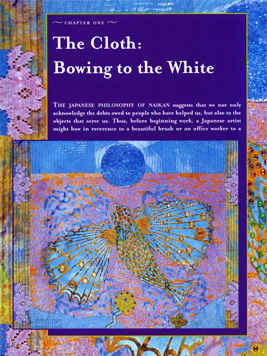
|
THE JAPANESE PHILOSOPHY OF NAIKAN suggests that we not only acknowledge the debts owed to people who have helped us, but also to the objects that serve us. Thus, before beginning work, a Japanese artist might bow in reverence to a beautiful brush ..... Although I may not physically bow, I agree with the philosophy and am grateful for the materials that are my co-creators.
As a surface designer, my collaborators are the fabric, the dyes and paints, and the application tools. Cloth is perhaps the most important component. It is both the raw material that receives the colors and the final product that goes into the world to become something else.
When the fabric arrives in my studio, it is white, unadorned, ready for me to apply color. But I know that every yard contains the invisible fingerprints of growers, scientists, spinners, weavers, and shippers. Sometimes, when I unroll a bolt of silk from China, I can even smell the rooms it passed through. I will never know all the personal stories I'm rinsing away as I prepare the fabric for dyeing, but knowing a little of the fiber's origin and history makes me appreciate the cloth more.
|

|
|
"Wherever you go today, tomorrow, or the rest of your life, you are part of someone's visual landscape. Why not make it beautiful?"
RAIN CLOTH: Because hand-painted fabric, especially silk, that hasn't been set is susceptible to water spotting, I often take advantage of the rain's patterning ability. When a sprinkle arrives, I grab newly painted fabric, which I've attached to cardboard beforehand, and rush outside. If there is no lightning, I enjoy standing by the fabric watching the drops move the dye around. Persuading the rain to stop at just the right point in my fabric design, however, has never been easy. So sometimes I have to make my own rain.
|
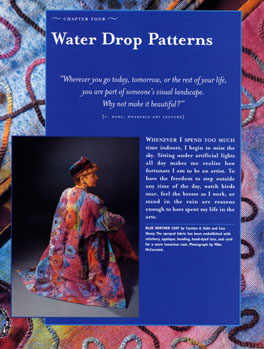
|

|
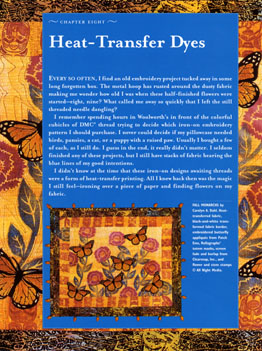
|
EVERY SO OFTEN, I FIND AN OLD EMBROIDERY PROJECT tucked away in some long forgotten box. The metal hoop has rusted around the dusty fabric making me wonder how old I was when these half-finished flowers were started — eight, nine? What called me away so quickly that I left the still threaded needle dangling?
I remember spending hours in Woolworth's in front of the colorful cubicles of DMC® thread trying to decide which iron-on embroidery pattern I should purchase. I never could decide if my pillowcase needed birds, pansies, a cat, or a puppy with raised paw. Usually I bought a few of each, as I still do. I guess in the end, it really didn't matter. I seldom finished any of these projects, but I still have stacks of fabric bearing the blue lines of my good intentions.
I didn't know at the time that these iron-on designs awaiting threads were a form of heat-transfer printing. All I knew back then was the magic I still feel — ironing over a piece of paper and finding flowers on my fabric.
|

|
|
BATIK IS THE FIRST WORD THAT COMES TO MOST MINDS WHEN A HOT WAX TECHNIQUE IS MENTIONED. Inspired by the exquisite beauty of Indonesian fabrics, many of us embarked on insanely ambitious batik projects. After days of dyeing and waxing, we ended up with permanently colored bathtubs and a closet full of board-like fabrics that never would release all their wax.
Yet, I have wonderful memories. I think of the process as a "grandmother technique" as it taught me so much about dyeing, the labor required, and respect for the craft. Whenever I come across a scrap from the fifteen yards of batiked curtains that clogged my bathtub drains with solidified wax, I still smile. I think everyone should try batik, at least once for the memories, and to develop a real appreciation for the simpler technique of dye painting with wax resist lines.
|
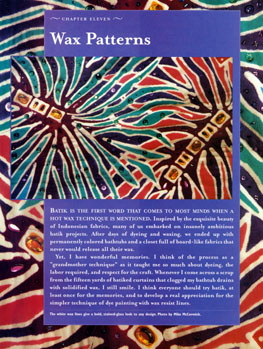
|

|
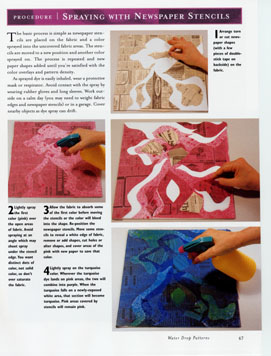
|
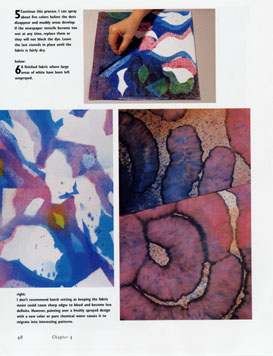
|
|
Demonstration of Spraying Dye with Newspaper Stencils
|
|
|

Copyright © 2004 - 2024 Carolyn Dahl
All images and text are protected by copyright law and may not be reproduced in whole or in part
without the written consent of Carolyn A. Dahl.
Dahlstudio@aol.com.
|







